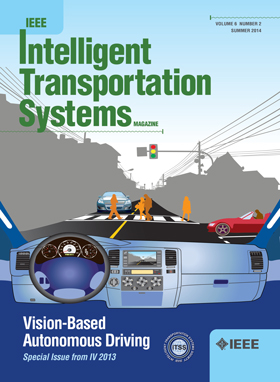Motion Estimation and Reconstruction for 360° Panoramic Images Based on Variant Goldberg Polyhedral Projection
IF 7.9
1区 工程技术
Q1 ENGINEERING, CIVIL
IEEE Transactions on Intelligent Transportation Systems
Pub Date : 2025-02-24
DOI:10.1109/TITS.2025.3541062
引用次数: 0
Abstract
The effectiveness of transportation systems is significantly influenced by the field of view (FOV) of cameras, with larger FOVs yielding more reliable performance. Conventional cameras with restricted FOV face difficulties in scenarios characterized by field-of-view shake or low-texture imaging areas, complicating feature extraction and matching tracking. Conversely, 360° panoramic cameras, which provide an expansive field of view and high pixel density, are emerging as promising alternatives. While many studies have explored motion calculation based on panoramic vision, most resort to conventional image processing methods for panoramic images, leading to inefficiencies and reduced accuracy. This article proposes a novel approach to panoramic vision motion estimation and reconstruction. The method involves projecting the panoramic image onto a fitting sphere and establishing a mapping relationship between a uniform spherical grid and the pixels of the panoramic image. This enables distortion-free mapping imaging for the entire panorama, addressing issues with matching consecutive frame images caused by distortion in the polar regions. Going beyond conventional epipolar constraints, this paper introduces a geometric constraint of epipolarity within a three-dimensional sphere and derives pose-solving equations tailored for panoramic vision, enabling motion estimation between frames. Additionally, it derives the polar arc equation of panoramic images, accelerating three-dimensional reconstruction of dense point clouds. The sliding window estimation method is used for iterative algorithm optimization, along with an optimization mechanism aligned with the panoramic camera model. Validation on public datasets and hardware experimental platforms demonstrates the proposed method’s significantly improved accuracy compared to existing optimal algorithms.基于变Goldberg多面体投影的360°全景图像运动估计与重建
交通运输系统的有效性受到摄像机视场(FOV)的显著影响,视场越大,性能越可靠。视场受限的传统相机在视场抖动或低纹理成像区域等场景中存在困难,使特征提取和匹配跟踪变得复杂。相反,提供广阔视野和高像素密度的360°全景相机正在成为有希望的替代方案。虽然有许多研究探索了基于全景视觉的运动计算,但大多数对全景图像采用传统的图像处理方法,导致效率低下,精度降低。提出了一种新的全景视觉运动估计与重建方法。该方法涉及将全景图像投影到拟合球体上,并建立均匀球面网格与全景图像像素之间的映射关系。这可以实现整个全景的无失真映射成像,解决由极地地区失真引起的连续帧图像匹配问题。超越传统的外极约束,本文引入了三维球面内的外极几何约束,并推导出适合全景视觉的姿态求解方程,从而实现帧之间的运动估计。此外,导出了全景图像的极弧方程,加速了密集点云的三维重建。采用滑动窗口估计方法进行迭代算法优化,并建立了与全景相机模型相匹配的优化机制。在公共数据集和硬件实验平台上的验证表明,与现有的最优算法相比,该方法的精度有了显著提高。
本文章由计算机程序翻译,如有差异,请以英文原文为准。
求助全文
约1分钟内获得全文
求助全文
来源期刊

IEEE Transactions on Intelligent Transportation Systems
工程技术-工程:电子与电气
CiteScore
14.80
自引率
12.90%
发文量
1872
审稿时长
7.5 months
期刊介绍:
The theoretical, experimental and operational aspects of electrical and electronics engineering and information technologies as applied to Intelligent Transportation Systems (ITS). Intelligent Transportation Systems are defined as those systems utilizing synergistic technologies and systems engineering concepts to develop and improve transportation systems of all kinds. The scope of this interdisciplinary activity includes the promotion, consolidation and coordination of ITS technical activities among IEEE entities, and providing a focus for cooperative activities, both internally and externally.
 求助内容:
求助内容: 应助结果提醒方式:
应助结果提醒方式:


